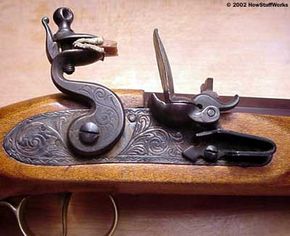The Flintlock Mechanism
The Merriam Webster Dictionary describes a lock, in the context of a gun, as "The method for exploding the charge or cartridge of a firearm."
The flintlock is the most venerable of the lock technologies. The flintlock mechanism, like the pendulum clock mechanism, is amazing from an innovation standpoint. This single device solved so many of the problems of the time, and it did so using the fairly primitive tools and technology already available then. The flintlock was quite an accomplishment!
Advertisement
The basic goal of the flintlock is simple: to create a spark that can light the gunpowder stored in the barrel of the gun. To create this spark, the flintlock uses the "flint and steel" approach. The idea behind flint and steel is straightforward. Flint is an amazingly hard form of rock. If you strike iron or steel with flint, the flint flakes off tiny particles of iron. The force of the blow and the friction it creates actually ignites the iron, and it burns rapidly to form Fe3O4. The sparks that you see are the hot specks of iron burning! If these sparks come near gunpowder, they will ignite it.
The flintlock therefore needs:
- A piece of flint
- A piece of steel
- A place for the sparks to touch gunpowder
The flint needs to move at high speed and strike the steel in such a way that the sparks fall into some gunpowder. You can see the four parts that make this happen in the picture below.
The main parts of a flintlock are:
- The hammer, which holds and accelerates a piece of flint
- The mainspring, which powers the hammer
- The frizzen, which is the piece of steel the flint strikes
- The pan, which is the place where a small quantity of gunpowder waits to receive the sparks
You can see these parts labeled in the picture below.
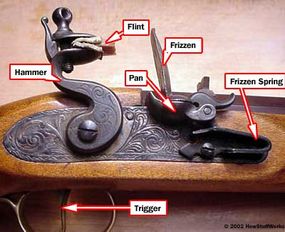
These four pieces are all that the flintlock actually needs to accomplish its goal, but all flintlocks also solve the problems of loading the pan, protecting the pan from the weather and triggering the hammer, so there are three additional parts:
- The tumbler, which holds and releases the power of the mainspring and transmits it to the hammer
- The sear and sear spring, which engage the tumbler and release it when someone pulls the trigger
- The frizzen spring, which holds the cover attached to the frizzen over the pan to make the flintlock weatherproof
The mainspring presses against the tumbler and is able to rotate the hammer with a great deal of force. The sear engages the tumbler when the gun is cocked and holds the force of the mainspring. When you pull the trigger, it pushes the sear enough to release the tumbler and allows the hammer to drive the flint forward. You can see all of these parts in the image below.

When you work with a flintlock and watch a flintlock in action you can see how all of these pieces work together. A flintlock has three positions for the hammer: uncocked, half-cocked and fully cocked.
In the fully cocked position, the gun is ready to fire. If the trigger moves the sear just a bit, it releases the tumbler. In the half-cocked position, you can load the gun. The trigger is locked in the half-cocked position and cannot release the tumbler. After you fire the gun, it is in the uncocked position. The following images show you these three positions from both sides of the lock, which allows you to understand how the sear and tumbler work together:
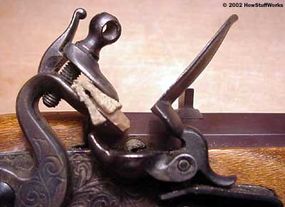
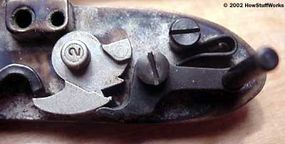
Note how the shape of the tumbler locks the half-cocked position:
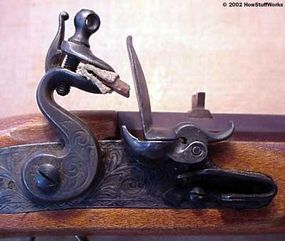
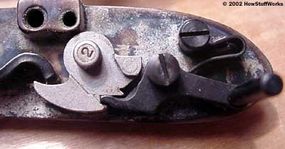
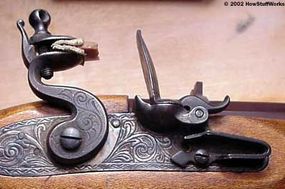
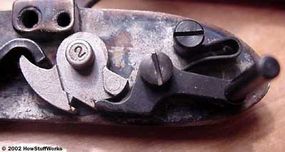
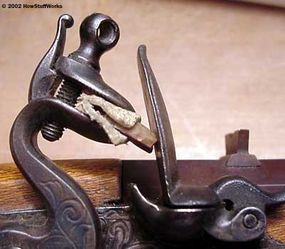
In addition, the frizzen has the ability to move. In the cocked position the frizzen is down, covering the pan. When the flint strikes it, the frizzen pops out of the way to expose the pan. The frizzen spring holds the frizzen in both positions.
To use a flintlock, you follow these steps: (see the links at the end of this article for much more detailed instructions):
- Half-cock the hammer.
- Pour a measure of gunpowder down the barrel.
- Wrap a lead ball (the bullet) in a small piece of cloth or paper and ram it down the barrel on top of the gunpowder. The bullet/cloth combination will have a nice, tight fit.
- Place a small amount of gunpowder in the flintlock's pan.
- Snap the frizzen in place over the pan.
- Fully cock the hammer.
- Pull the trigger to fire the gun.
When you fire the gun, the flint strikes the frizzen and shaves off iron to create sparks. The hammer's blow also snaps the frizzen back to expose the gunpowder in the pan. The pan's gunpowder ignites, and it flashes through a small hole in the side of the barrel to ignite the gunpowder inside the barrel. The gun fires!
Videos!
These three videos let you see and hear the flintlock in action:
